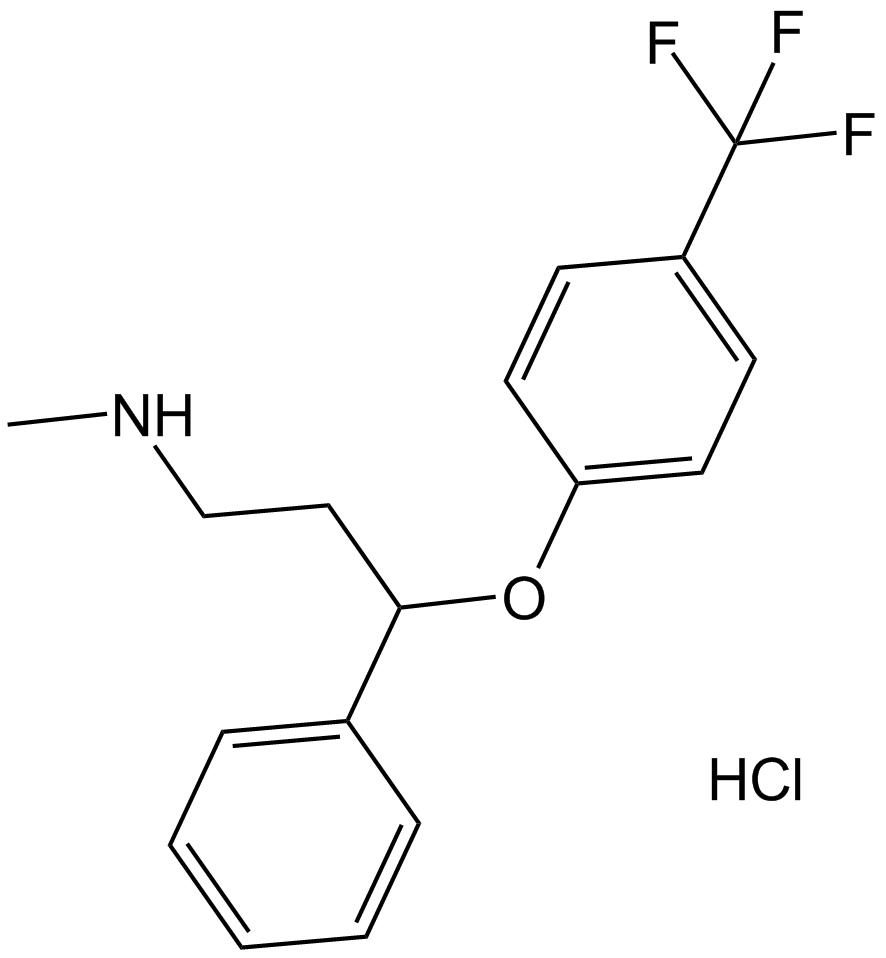Fluoxetine HCl (Synonyms: LY110140) |
| Catalog No.GC11709 |
Serotonin reuptake inhibitor,selective
Products are for research use only. Not for human use. We do not sell to patients.

Cas No.: 56296-78-7
Sample solution is provided at 25 µL, 10mM.
Fluoxetine is a specific presynaptic serotonin-reuptake inhibitor (SSRI) at the neuronal membrane, used in the treatment of depression.
The serotonin receptor, also known as 5-HT receptor, is a member of G protein-coupled receptorfound in the central and peripheral nervous systems. The serotonin receptors, activated by the natural ligand serotonin,have been involved in a variety of biological and neurological processes such as aggression, anxiety, cognition, learning, memory, mood[1].
In vitro:In Xenopusoocytes expressing either cloned 5HT2C receptors or 5HT receptors, micromolar concentrations of fluoxetine (Prozac) inhibited the membrane currents elicited by serotonin (5-hydroxytryptamine; 5HT). For responses elicited by 1 μM 5-HT, the IC50 of fluoxetine was about 20 μM. Fluoxetine also inhibited the binding of [3H]5HT to 5HT2C receptors expressed in HeLa cells and the binding of [3H]5HT to 5HT receptors in rat cortex membranes, with Ki of ≈65–97 nM and ≈ 56 μM, respectively[2]. Administration of fluoxetine blocked the downregulation of cell proliferation of hippocampal cells resulting from inescapable shock (IS), which resulted in a state of behavioral despair[3]. Fluoxetine increased the number of newborn cells in the dentate gyrus of the hippocampus of adult rat. Fluoxetine also increased the number of proliferating cells in the prelimbic cortex[4]. Fluoxetine accelerated the maturation of immature neurons. Fluoxetine enhanced neurogenesis-dependent long-term potentiation (LTP) in the dentate gyrus [5]. Fluoxetine, but not other selective serotonin uptake inhibitors such as citalopram, fluvoxamine, paroxetine and sertraline, increased norepinephrine and dopamine extracellular levels in prefrontal cortex. Fluoxetine produced robust and sustained increases in extracellular concentrations of norepinephrine and dopamine after acute systemic administration [6].
In vivo: Fluoxetine reversed the deficit in escape latency observed in animals exposed to inescapable shock in adult male Sprague–Dawley rats [3].The combination of olanzapine and fluoxetine produced robust, sustained increases of extracellular levels of dopamine ([DA](ex)) and norepinephrine ([NE](ex)) up to 361 ± 28% and 272 ± 16% of the baseline, respectively[7]. Fluoxetine (5 and 10 mg/kg) reduced cocaine infusions (0.2 mg/kg), and cocaine infusions returned to baseline levels within 48 hr after fluoxetine treatments were terminated [8]. In sham-operated or adrenalectomized/castrated (ADX/CX) male rats, administration of fluoxetine dose-dependently (2.9-58 mumol/kg i.p.) increased the brain content of the neurosteroid 3 alpha-hydroxy-5 alpha-pregnan-20-one (allopregnanolone, 3 alpha, 5 alpha-TH PROG)[9].
Clinical trials: In a 5-wk double-blind, parallel study with 40 depressed 23–69 yr olds, fluoxetine(20–80 mg/day) provided effective antidepressant activity, with fewer and less side effects[10].
References:
[1]. Hoyer D, Clarke DE, Fozard JR, Hartig PR, Martin GR, Mylecharane EJ, Saxena PR, Humphrey PP (1994)."International Union of Pharmacology classification of receptors for 5-hydroxytryptamine (Serotonin)".Pharmacol. Rev.46(2): 157–203.
[2]. Ni Y G, Miledi R. Blockage of 5HT2C serotonin receptors by fluoxetine (Prozac)[J]. Proceedings of the National Academy of Sciences, 1997, 94(5): 2036-2040.
[3]. Malberg J E, Duman R S. Cell proliferation in adult hippocampus is decreased by inescapable stress: reversal by fluoxetine treatment[J]. Neuropsychopharmacology, 2003, 28(9): 1562-1571.
[4]. Kodama M, Fujioka T, Duman R S. Chronic olanzapine or fluoxetine administration increases cell proliferation in hippocampus and prefrontal cortex of adult rat[J]. Biological psychiatry, 2004, 56(8): 570-580.
[5]. Wang J W, David D J, Monckton J E, et al. Chronic fluoxetine stimulates maturation and synaptic plasticity of adult-born hippocampal granule cells[J]. The Journal of neuroscience, 2008, 28(6): 1374-1384.
[6]. Bymaster F P, Zhang W, Carter P A, et al. Fluoxetine, but not other selective serotonin uptake inhibitors, increases norepinephrine and dopamine extracellular levels in prefrontal cortex[J]. Psychopharmacology, 2002, 160(4): 353-361.
[7]. Zhang W, Perry K W, Wong D T, et al. Synergistic effects of olanzapine and other antipsychotic agents in combination with fluoxetine on norepinephrine and dopamine release in rat prefrontal cortex[J]. Neuropsychopharmacology, 2000, 23(3): 250-262.
[8]. Carroll M E, Lac S T, Asencio M, et al. Fluoxetine reduces intravenous cocaine self-administration in rats[J]. Pharmacology Biochemistry and Behavior, 1990, 35(1): 237-244.
[9]. (Uzunov D P, Cooper T B, Costa E, et al. Fluoxetine-elicited changes in brain neurosteroid content measured by negative ion mass fragmentography[J]. Proceedings of the National Academy of Sciences, 1996, 93(22): 12599-12604.
[10]. Bremner J D. Fluoxetine in depressed patients: a comparison with imipramine[J]. Journal of Clinical Psychiatry, 1984.
Average Rating: 5 (Based on Reviews and 31 reference(s) in Google Scholar.)
GLPBIO products are for RESEARCH USE ONLY. Please make sure your review or question is research based.
Required fields are marked with *




















